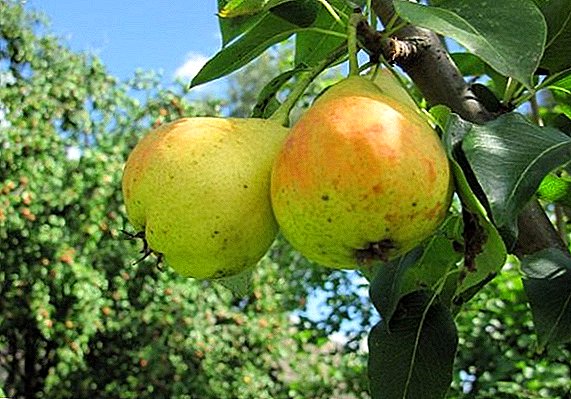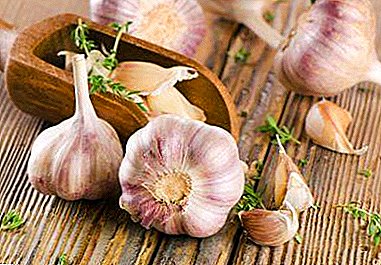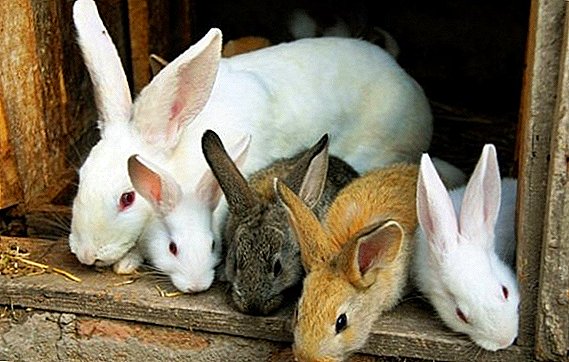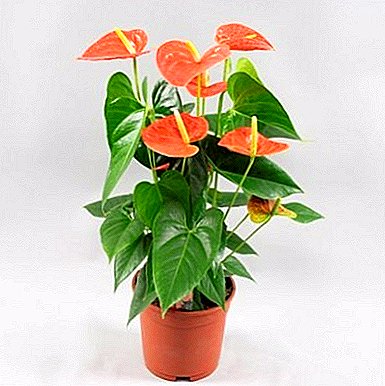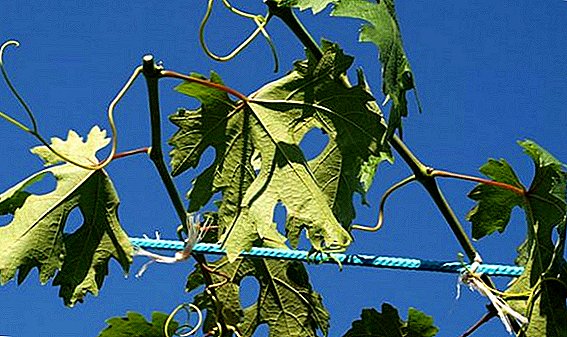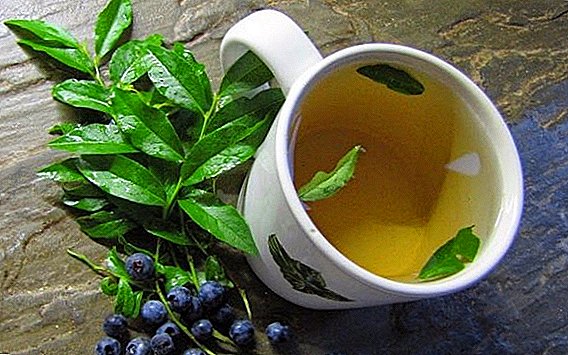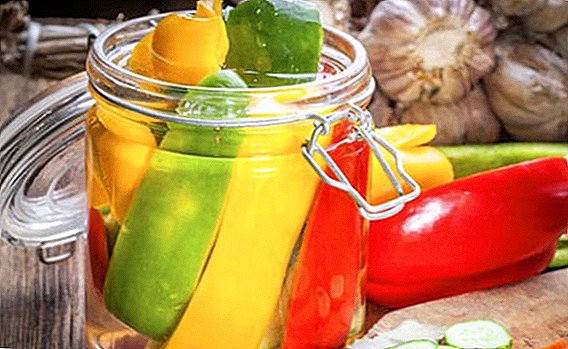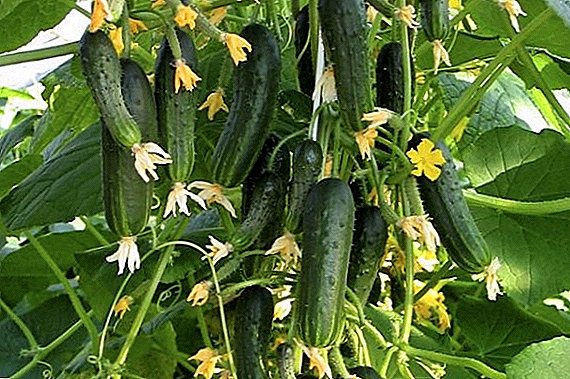 Breeding science during its existence has brought so many varieties and hybrids of vegetable plants, that sometimes gardeners and gardeners face the difficult task of choosing the best of them. In this article we will introduce you to a bunch of cucumbers "Bouquet F1". You will learn about its features, conditions of growing, collecting and storing the crop.
Breeding science during its existence has brought so many varieties and hybrids of vegetable plants, that sometimes gardeners and gardeners face the difficult task of choosing the best of them. In this article we will introduce you to a bunch of cucumbers "Bouquet F1". You will learn about its features, conditions of growing, collecting and storing the crop.
Variety description
“Bouquet” is a parthenocarpic hybrid, which means that it can produce fruit without pollination. Cucumbers are formed without seeds inside. The hybrid is characterized by precocity - the fruits ripen after 38-42 days after germination, as well as abundant and long-term fruiting. In one bouquet tied from 2 to 6 knots.
Check out the most famous varieties of parthenocarpic cucumbers.
The bush is not too tall, weakly branching, with a predominance of female flowers. Medium-sized leaves of beautiful green color are formed on the lashes. Fruiting occurs in June, ends in the fall.
The main advantages of the hybrid are:
- the ability to grow it in open and closed ground conditions;
- resistance to ailments characteristic of cucumbers, in particular, to field mosaic (PTO-1), powdery mildew, cladosporioz;
- powdery mildew tolerance;
- good taste characteristics of fruits, absence of bitterness and hollowness in them at any stage of development;
- high yield;
- ease of care.

Did you know? Translated from the Greek, "parthena" means a virgin, and parthenogenesis means the immaculate conception. Therefore, cucumbers that form fruits without insects and pollination are called parthenocarpic. The ovary is formed on female flowers.
Fruit characteristics and yield
Short spindle-shaped gherkins weighing 90-110 g each ripen on the cucumber bush. They are medium in size - from 9 to 12 cm long and 3-4 cm in diameter. On the skin there are strips of medium size, tubercles, white spikes. Possess good taste. The yield is 5-7 kg per 1 square. m. Cucumbers are eaten fresh and also used for canning.
Selection of seedlings
It is best to grow cucumbers yourself. However, if there is no possibility of planting and sprouting seedlings, then it will have to be purchased on the market. In this case, it will not be superfluous to know how to choose the right quality shoots.
If growing ordinary varieties of cucumbers is no longer of interest to you, we advise you to familiarize yourself with the exotic varieties of this plant.
The choice should be based on the external qualities of the shoots. So, the seedlings should be:
- age 30 days;
- with a durable stem about 25-30 cm high;
- with 5-6 true leaves that have a beautiful green color and a healthy appearance (the lower leaves should be 16-20 cm in diameter);
- with shortened internodes;
- with kneeless knee length 5 cm;
- with an intact, well developed root system with a pleasant smell.
VIDEO: HOW TO CHOOSE THE BEST CROWN When choosing, you should carefully examine the areas under the leaves for the presence of harmful insects. It is necessary to abandon the purchase of seedlings that have:
- elongated thin stem;
- light small leaves.
Find out when it is best to plant cucumbers for seedlings.
Most likely, during the cultivation of such seedlings such an important condition was violated as the length of daylight, or there were other violations of technology.
It is advisable to purchase seedlings from trusted vendors that you trust. Otherwise, you should collect as much information about it from the implementer. 
Did you know? The biggest cucumber in the world has grown Briton Claire Pierce. The vegetable had a length of 1.19 m. According to its owner, it was grown from expired seeds that had been stored for about 2 years.
Seedlings can be sold both in containers and with an open root system. The first has a higher percentage of survival rate and higher cost.
Soil and fertilizer
Cucumbers grow best in loam and sandy loams that are rich in minerals and vitamins and have a neutral or slightly increased acidity.
The best precursors for cucumbers are potatoes, onions, tomatoes, cabbage. The worst are watermelon, melon, zucchini, cucumber, pumpkin, squash. In the soil after these crops can remain pathogens common with cucumber diseases and common harmful insects.
Before planting cucumbers in open or protected ground, the soil will need to be prepared. Preparation will vary depending on where the plants are grown.
In order to achieve the maximum yield in the open ground from the hybrid "Bouquet", it is necessary to equip warm beds, which should be placed on a well-clarified area, warmed up by sunlight and protected from drafts.  Gardener crop rotation
Gardener crop rotation
Important! Before planting the bed will need to warm up. To do this, over it a few days before planting cucumbers on the arcs, a film or nonwoven covering material is installed.
Warm beds are prepared by forming several layers in advance. The first, lowest layer must be drainage. For its equipment suitable straw, grass, branches. These materials will be able to divert moisture from the roots. The drainage layer is laid at a depth of 30-50 cm and compacted. The second layer is formed from fresh manure. Already in spring the third layer is piled up - from the fertile land.
In the absence of the possibility of preparing land for planting in the fall, it is prepared in the spring, but with somewhat different technology. The bottom layer is formed from manure or compost, to which wood ash (3 cups) and nitrophoska (100 g / 1 sq. M) is added. The second layer should be fertile soil. From above the bed is covered with a film, which is pressed to the ground by weights. Warm up under the film area should be within a week. After that, the beds make holes, sow seeds in them or plant seedlings, install the film on the arcs.
We recommend to learn what soil acidity is and how to determine it at home.
In the greenhouse, the land preparation process can begin in the spring. The top layer of soil is removed, and a 30-40 cm layer of manure is placed in its place. In it you need to make a few holes, in which pour hot water. The dung will be overheated for several days. As a result of the natural processes of debate, heat will be emitted to the bed.  Immediately before planting, a fertile substrate prepared from sod land (2 parts), humus (2 parts), sand or sawdust (1 part) should be poured on top of the manure. The soil will need to be disinfected by spilling it with a solution of potassium permanganate.
Immediately before planting, a fertile substrate prepared from sod land (2 parts), humus (2 parts), sand or sawdust (1 part) should be poured on top of the manure. The soil will need to be disinfected by spilling it with a solution of potassium permanganate.
Growing conditions
Cucumbers are heat and light-loving plants, so in the garden for them you need to allocate a well-lit area. The plant will start growing and will develop well at an air temperature of + 22 ... +26 degrees. And in the greenhouse it is necessary to maintain the temperature at + 18 ... +20 degrees.
Soil temperature should not fall below +16 degrees. The optimal performance for normal growth is + 20 ... +24 ° C.
Important! If the temperature falls below +14 degrees or rises above +42, then this adversely affects the development of the plant - it stops growing. And even short frosts up to 0 degrees can destroy cucumbers. Lowering the thermometer for 24 hours to +5 degrees plants tolerate without consequences. Dangerous for cucumber bushes and sudden temperature changes.Light day should be maintained at the level of 10-12 hours. Otherwise, the plant develops poorly, quickly grows old, weakens, becomes susceptible to diseases and pests. If the light day lasts 16 hours and longer, then fruiting periods are delayed.
 The favorite soil moisture of cucumbers is 65-75%, and in the fruiting phase - up to 80%. The optimum air humidity is 85-90%, in cloudy weather it can be reduced to the level of 70-80%.
The favorite soil moisture of cucumbers is 65-75%, and in the fruiting phase - up to 80%. The optimum air humidity is 85-90%, in cloudy weather it can be reduced to the level of 70-80%.This vegetable culture very sensitively reacts to changes in humidity, therefore at its increase during a week up to 95% it starts to suffer from ascochitis. When lowered to 60% fade.
Growing from seed to seedlings at home
Sowing cucumbers can be done in three ways:
- dry seeds;
- germinated seeds;
- using seedlings.
To grow seedlings from seeds, it is necessary to prepare the soil, planting material, to prepare containers. After planting, it will be necessary to ensure recommended temperature and humidity conditions, moistening, airing and hardening of seedlings.
Seed preparation
Shoots ripen to the point where they can be planted in the ground, for 20-30 days. Therefore, sowing should be calculated based on when cucumbers are planted in your area.  If the seeds are purchased in a reputable specialty store, then they do not need processing. They just need to be planted in a well-moistened substrate. In the case of acquiring them from friends or on the market will require soaking in potassium permanganate or in the preparation "Epin" - this will disinfect the planting material.
If the seeds are purchased in a reputable specialty store, then they do not need processing. They just need to be planted in a well-moistened substrate. In the case of acquiring them from friends or on the market will require soaking in potassium permanganate or in the preparation "Epin" - this will disinfect the planting material.
Content and location
The optimum temperature for the cultivation of seedlings is + 20 ... +22 degrees during the day and +18 at night. Mold appears on the seed, which is planted in the soil with temperature indicators below 12 degrees, so the capacity of the seedlings must be placed in a room in which you can create such conditions. Daylight should be maintained at 10-12 hours. Direct sunlight for young shoots is destructive.
The best tanks for sowing seeds and growing seedlings are peat pots.
Learn about the secrets of planting seedlings in peat tablets.
Plastic containers are also suitable, cups with dimensions of 10 by 10 cm. It is better if each sprout initially grows in a separate container, since the transplantation of young shoots is poorly tolerated.  Sowing seeds in peat pots. Tanks are filled with a specially prepared substrate of the following components:
Sowing seeds in peat pots. Tanks are filled with a specially prepared substrate of the following components:
- turf ground;
- peat;
- sand;
- drainage (expanded clay, vermiculite and other materials).
It is useful to know how to choose the right capacity for seedlings.
Seed planting process
In a moist and heated soil in each of the containers a small depression is made - up to 2 cm deep, in which 1-2 seeds are put. On top of the seeds are sprinkled with soil substrate. Before germination, which usually occurs after 2-3 days, the containers should be in a room with a temperature of + 22 ... +28 degrees.
Seedling care
Water the seedlings only with heated water. It is advisable to carry out moistening in the first half of the day, because if the moisture is retained at night, fungal diseases can develop.
Watering at the growth stage is carried out every other day, then they switch to daily moisture.  When 2 true leaves are formed on the seedlings, they can be fed. To do this, use complex fertilizer "Stimul-1" or mullein, diluted with water in a ratio of 1 to 1. It is also possible to make a mixture of superphosphate (20 g / 10 l), ammonium nitrate (10 g), potassium chloride (15 g). In the latter case, fertilization is carried out twice: a week after the formation of shoots and 2 weeks after the first feeding.
When 2 true leaves are formed on the seedlings, they can be fed. To do this, use complex fertilizer "Stimul-1" or mullein, diluted with water in a ratio of 1 to 1. It is also possible to make a mixture of superphosphate (20 g / 10 l), ammonium nitrate (10 g), potassium chloride (15 g). In the latter case, fertilization is carried out twice: a week after the formation of shoots and 2 weeks after the first feeding.
Important! If before planting in the ground, the race begins to bloom, then the flowers will need to be removed.A week before the intended landing of seedlings to a permanent place should begin the process of hardening. The containers are carried out to fresh air, starting from 5 minutes a day, each day increasing the time the sprouts stay on the street. The day before planting, the soil in the seedlings should be well moistened.
Transplanting seedlings to ground
All varieties of cucumbers, even differing in the highest level of resistance to cold, with a decrease in temperature, suffer from a delay in growth and development, which means that they later bear worse fruit. Therefore, haste with sowing or planting seedlings in open ground is fraught with undesirable consequences, including a decrease in yield.  The most optimal time for sowing seeds or planting seedlings in the middle lane in the greenhouse is from May 15 to 20, in the open ground from June 1 to 5. In the northern regions of the garden, the start of cucumber cultivation should be in the first 10 days of June. The soil in the area should warm up to + 16 ... +18 degrees, and the air - to + 18 ... +20 degrees.
The most optimal time for sowing seeds or planting seedlings in the middle lane in the greenhouse is from May 15 to 20, in the open ground from June 1 to 5. In the northern regions of the garden, the start of cucumber cultivation should be in the first 10 days of June. The soil in the area should warm up to + 16 ... +18 degrees, and the air - to + 18 ... +20 degrees.
The fact that the seedlings are ready to move to a permanent place of growth, she tells the appearance. Shoots should have strong stems not less than 30 cm high, well-formed leaves of beautiful green color in the amount of 3-5 pieces, well-developed roots.
On 1 square. m open ground can be placed up to 5 bushes. In the greenhouse planting density is 3 bush per 1 square. m. The scheme of planting cucumbers in the garden does not matter. In the greenhouse, the “Bouquet” planting is carried out by the two-row method with a distance between the rows of 50 cm, between the rows - 30 cm.  If the seedlings were planted in peat pots, then they are placed in pre-prepared holes so that their edges equal the level of the ground. Then they are watered using 3 liters of water for each sprout. If the seedlings grew in plastic cups, then they are cut, and the plants are planted, without destroying the earth lump. Well-developed sprouts are planted in an upright position. Several weakened seedlings can be placed in the soil at an angle.
If the seedlings were planted in peat pots, then they are placed in pre-prepared holes so that their edges equal the level of the ground. Then they are watered using 3 liters of water for each sprout. If the seedlings grew in plastic cups, then they are cut, and the plants are planted, without destroying the earth lump. Well-developed sprouts are planted in an upright position. Several weakened seedlings can be placed in the soil at an angle.
In the first days after planting, young shoots should be provided with shading from sunlight and high-quality watering with warm water. When the temperature drops to 15 degrees will require the installation of the film on the arcs.
Agrotechnics growing seeds in open ground
In the northern regions it is better to grow cucumbers only with the help of seedlings. In other localities, planting is possible in a seedless manner immediately in the garden. However, as is the case with other methods, in order to achieve high yields from a cucumber, it needs to create suitable conditions for this.
Outdoor conditions
We have already spoken about many conditions, such as temperature, crop rotation, soil composition and arrangement of warm beds. Plot for a plant in the garden should be sunny, sheltered from the winds. At first, after landing, it is advisable to cover the area with a film on the arcs. 
The process of planting seeds in the ground
With a non-seedling method, seed can be planted either in a dry form or by soaking it beforehand. You can also make complete seed treatment, including disinfection, hardening, and soaking.
Disinfection is performed by heating the seeds at a temperature of 60 degrees for 3 hours and soaking them for 15 minutes in a solution of potassium permanganate (1 g) and boric acid (0.2 g) in water (10 l).
For germination, seeds are placed in a damp cloth and kept at a temperature of + 20 ... +25 degrees until the moment they hatch. After that, for several days, they are placed first on the top shelf of the refrigerator for hardening, and then on the bottom.  The sowing process is simple - a small sloping hole is dug out in a moistened soil with a chopper, 2-3 seeds are sown to a depth of 2-3 cm and sprinkled with soil.
The sowing process is simple - a small sloping hole is dug out in a moistened soil with a chopper, 2-3 seeds are sown to a depth of 2-3 cm and sprinkled with soil.
It is recommended to sow in three terms at weekly intervals. So, if frost happens suddenly, later plants can survive. When it will be clear that the temperature will not decrease again, the extra shoots will need to be removed.
After the seedlings appear, the soil must be loosened. With the advent of the first leaves, the seedlings are thinned, leaving 10-15 cm gaps between the plants and 3-4 sprouts in one hole.
VIDEO: LANDING OF CUCUMBERS IN AN OPEN GROUND Further care is regular watering, loosening and weeding, garter and fertilizer.
Watering
An important condition for the proper development of the plant is watering with extremely warm water - not less than 23 degrees. If you water it with cold water, then cracks form on the stem, which later penetrate bacteria and fungi that cause diseases.
Watering is carried out in the afternoon after warming up the air and soil. For young plants will require water in the amount of 5-10 liters per 1 square. m. When the plant releases flowers, it is temporarily stopped watering. After setting fruit regular watering resume. During this period, it will be necessary to pour out already 15-20 liters per 1 square meter. m
It is possible to grow cucumbers not only in the greenhouse or in the open field, but also on the balcony, hydroponics, in bags, buckets, barrels, plastic bottles.
If on the street for a long time there is a dry hot weather, then watering should be done more intensively. With heavy rains their volume and quantity are reduced.  Drip irrigation cucumber
Drip irrigation cucumber
Soil loosening and weeding
Loosening is necessary in order to better pass air through the soil to the roots. And when watering, the soil is usually crusted or compacted. If loosening is not done, the growth of plants will linger, and the ovary will fall off. Therefore, it is very important to loosen the soil after each precipitation and watering, as soon as the top layer dries out slightly.
Since the roots of cucumber bushes are superficial, then it is necessary to loosen gently and shallowly - no deeper than 4 cm. If there is peaty soil on a section, then it is necessary to pierce it with a fork in several places.
Weeding is carried out in order to remove weeds in the beds, which take nutrients and sunlight from the cultivated plant. Plot weed as needed. If the pollution is not strong, then manually removing grass with a root is possible.
Masking
Since the "Bouquet" refers to the parthenocarpic, it does not stepchild, but pinch the central stem, leaving only 2-3 side shoots on the bush. This allows you to increase the yield of the bush. When limiting the growth of the central stem, the side branches begin to branch, tying new fruits in the leaf axils. 
Garter
Garter is necessary in order to save space on the garden, to avoid the development of diseases when cucumbers come into contact with the soil for convenient harvesting. There are several ways to garter cucumbers in the open field:
- horizontal;
- vertical;
- on the grid.
Also use a garter on the trellis, planted culture along the fence. The horizontal method is the simplest and most common among beginners in the garden business. Horizontal garter At the edges of the beds, two metal supports or wooden beams are installed, on which a string is stretched in several rows with a distance of 25-30 cm. Cucumber stems are fixed on the bottom support. In the future, the plant as it grows is attached to the rope itself.
Horizontal garter At the edges of the beds, two metal supports or wooden beams are installed, on which a string is stretched in several rows with a distance of 25-30 cm. Cucumber stems are fixed on the bottom support. In the future, the plant as it grows is attached to the rope itself.
With the vertical method, supports are also installed along the edges of the bed. Twine is stretched horizontally only from above. Along its entire length, tissue strips 2-3 cm wide are snapped. There should be as many of them as there are bushes in the garden. The lower end of the strip is tied to the stem.  Vertical cucumber garter Net for tying can be purchased at a specialty store. She pulls on support.
Vertical cucumber garter Net for tying can be purchased at a specialty store. She pulls on support.
Top dressing
Cucumbers are recommended to feed 3 times per season. The first dressing can be made immediately after the appearance of the first true leaves. For this purpose, suitable infusion of mullein. The second feeding is carried out 2-3 weeks after the first. The third is before joining the lash.
In addition to the mullein, cucumbers can also be fertilized with a mixture of ammonium nitrate (10 g), potassium salt (10 g), superphosphate (10 g), diluted in 10 liters of water.
Foliar fertilization is carried out as needed. Apply a mixture of superphosphate (12 g), potassium chloride (7 g), urea (5 g), diluted in 10 liters of water. The volume of working solution - 0.5 liters per 1 square. m
VIDEO: SUPPORTING CUCUMBERS DURING FLOWERING
Pests, diseases and prevention
In the characteristics of the variety "Bouquet", we indicated that it has immunity against mosaic, powdery mildew, cladosporia, downy mildew. Nevertheless, the culture may suffer from fusarium wilt, rot.
In the fight against illnesses and pests, preventive measures take the first place:
- to avoid fusarium, the soil at the site before planting is watered with the drug "Fitosporin";
- white, gray and root rot can be prevented, if you do not ignore the recommendations for irrigation with warm water, keep the distance between the bushes, weed in a timely manner, to prevent the freezing of cucumbers. It is also important to ensure that the area does not stagnate moisture. In the case of the development of gray rot, the plants are sprayed with Fitosporin, and the white with Topaz. Root rot is fought with a solution of copper sulfate;
Important! In the treatment of diseases, it is necessary to strictly follow the recommendations for the preparation of the drug indicated on the package, as well as to observe personal safety measures, protecting the respiratory tract, eyes and body.
- Cucumbers most often suffer from attacks of whitefly, sprout flies, spider mites, tobacco thrips, gall nematodes, aphids, and springtails. Each of the insects can be fought both by folk methods and well-proven insecticides. So, the sprout fly is destroyed by Iskra, the whitefly and springtail - by Aktar, Konfidor, Aktellik, Inta-Vir. "Fitoverm" helps to get rid of the tick, "Decis" and "Intavir" help from aphids. Against thrips effective "Aktara", "Fufanon", "Golden Spark". Against the nematode - "Marshall".
 Whitefly on cucumbers
Whitefly on cucumbersHarvesting and storage
After the first fruits begin to appear, they will need to be regularly cleaned. In the phase of mass fruiting, the bypass of the beds is done daily, morning and evening. The rest of the time - after 1 or 2 days.
Learn how to preserve cucumbers for the winter.
Fruits are broken by twisting. When walking around the beds, not only ripe gherkins are removed, but also damaged, irregular in shape, diseased, otherwise they will weaken the bush. When collecting it is forbidden to pull and pull the lash.
Storage of cucumbers is carried out in the refrigerator. Their shelf life is 1-2 weeks.
Possible problems and recommendations
Of course, rarely when growing cucumbers goes without problems. However, the main thing is to pay attention in time to the fact that the development of plants is going wrong, to know the cause and to be able to correct it.
The fact that the plant is missing something, it will signal the appearance. Thus, the yellowing of the lower leaves and the formation of irregularly shaped gherkins with fair skin, most likely, indicates a nitrogen deficiency. Having noticed such signs, you should immediately feed the vegetable with urea (2 tablespoons / 10 liters of water). For 1 bush 0.5 liters of fertilizer is required.  If the side shoots do not develop on the bush, and the young leaves dry out almost immediately after they appear, then cucumbers need phosphorus. Add superphosphate under the bush (3 tablespoons / 10 liters of water). Under 1 bush should go 0.5 liters of fertilizer.
If the side shoots do not develop on the bush, and the young leaves dry out almost immediately after they appear, then cucumbers need phosphorus. Add superphosphate under the bush (3 tablespoons / 10 liters of water). Under 1 bush should go 0.5 liters of fertilizer.
Often culture lacks potassium. In this case, a yellow border appears on the sheets, and the gherkins are shaped like pears. Potassium replenishment is made with the introduction of wood ash (1 cup / 10 l of water). It will take 3 liters per 1 square. m
The fact that cucumber does not have enough calcium, he will tell by twisting the leaves, faded greens, shedding flowers. In this situation, under each plant, you need to make a half-liter solution of 3 tablespoons of calcium nitrate, diluted in 10 liters of water. 
Did you know? For the first time, people began to cultivate cucumbers about 6 thousand years ago. India is considered the birthplace of the plant. At the foot of the Himalayas and today you can find wild cucumbers.In conclusion, we want to note that the hybrid "Bouquet F1", as a rule, includes the ten best varieties of cucumbers. It is suitable for growing in vegetable gardens and film constructions. This is a great option for lovers of fast harvest and medium-sized fruits of the gherkin type, which are suitable for canning in small containers. For successful cultivation of a hybrid, proper preparation of the soil, planting seeds or seedlings at the recommended time, carrying out timely measures for the care and prevention of the development of diseases and pest attacks are necessary.
Cultivation Reviews




